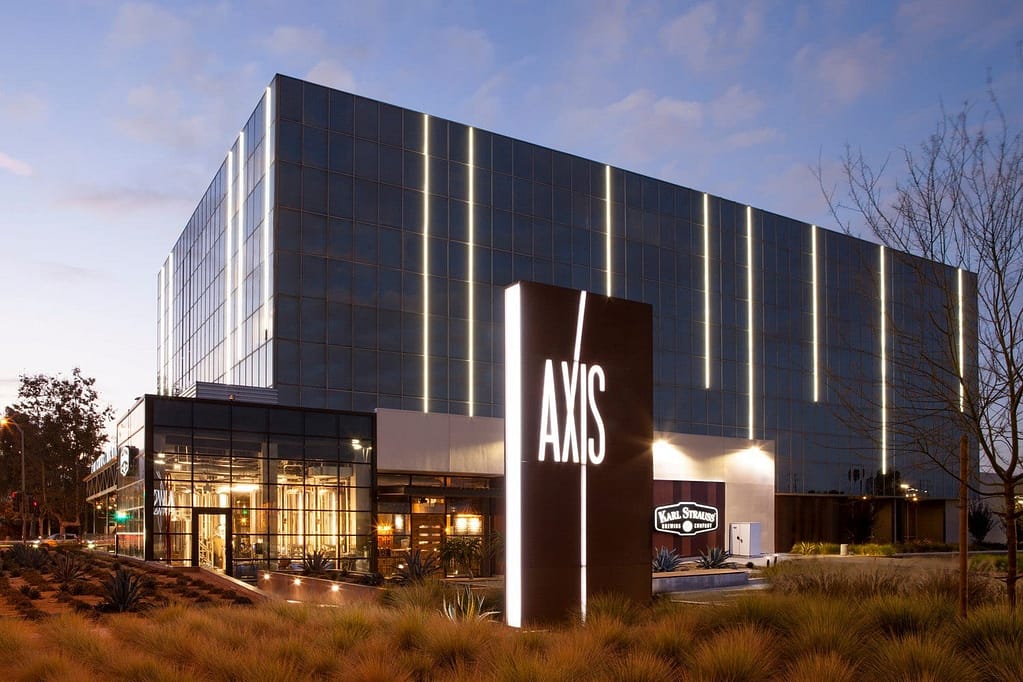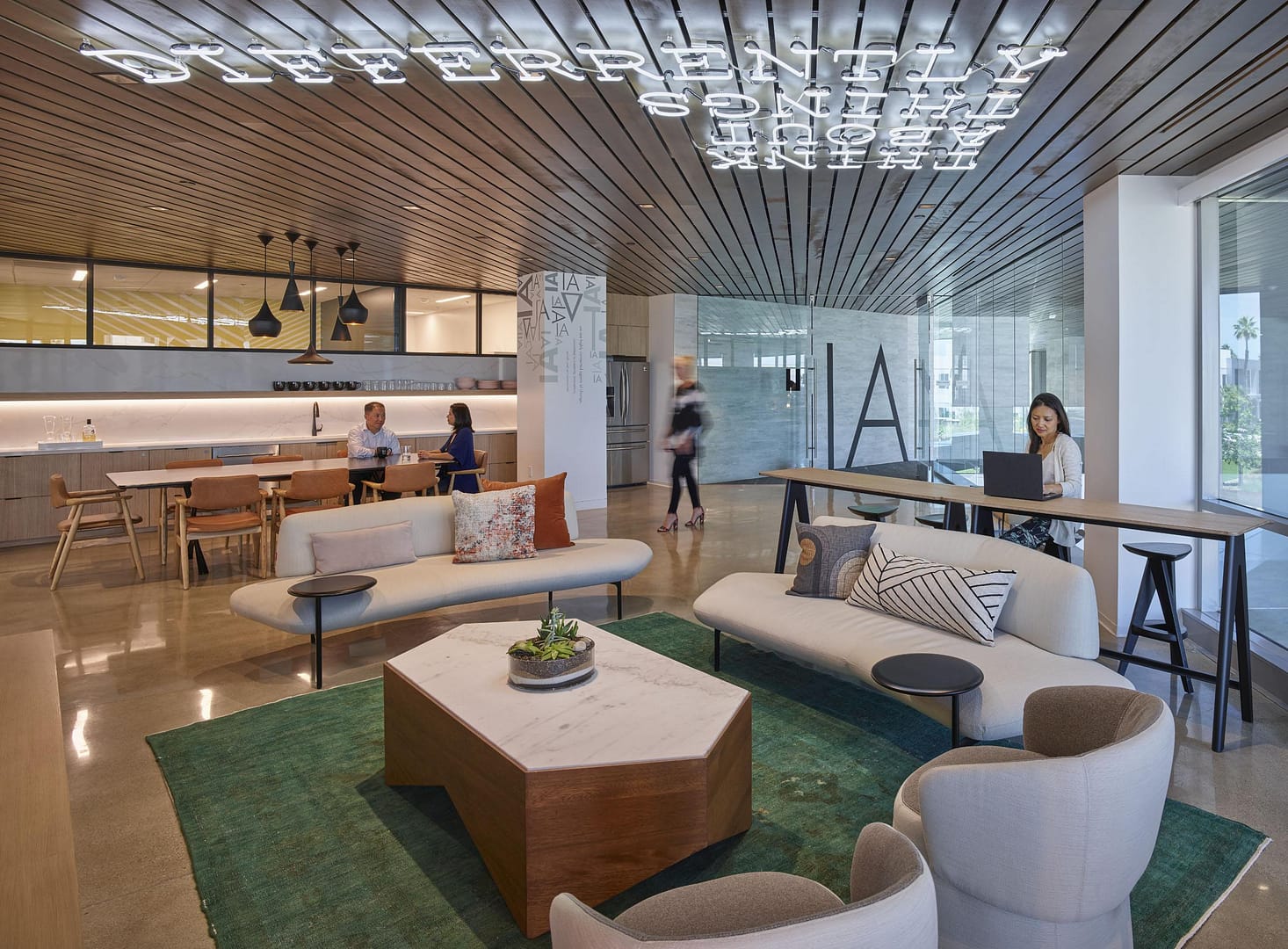
The IA team invited a craft brewery to open a restaurant on the corner of the property across from Angel Stadium of Anaheim. Axis Campus, Anaheim, CA. Photography © Kim Rodgers.
Back from the dead? You might put it that way–properties ignored and empty, some completely deserted for years in areas of suburban or urban decline, now reimagined, repositioned, in demand, and a community resource. How do such transformations happen; what is the process? Although each is unique, considering the many projects of this type in IA’s portfolio, we can broadly identify four general steps in the process.
Step one: Assess the candidate property from an urban planning prospect. What is its potential; what are the negatives? What’s nearby; any restaurants, outdoor areas, or local attractions? Is it convenient to transportation, on a corner, or set back from the street? How about parking?
Step two: What is the property’s history? Does it have a reputation? Is it just forgotten or plagued by a negative legacy? Will a rigorous rebranding make a difference?
In both suburban and urban business districts, older buildings and campuses in need of a major refresh to realize their full potential are well suited for a repositioning. If the bones are good, repositioning speaks to sustainability, is less expensive than new construction, and may be just the infusion of creativity, energy, and innovation the area needs. With many older buildings in Southern California business districts, it’s no surprise that IA’s Orange County office has completed several stellar examples of such projects.
Case in point, #1: When a global real estate organization acquired a 15-acre, four-building campus (the former Washington Mutual headquarters) in Irvine, California, virtually vacant for several years, IA was tasked to reposition the property as a next-generation, multi-tenant campus designed to bring something new to market. But what? Considering outdoor-loving Southern California and the current interest in health and wellness, the IA team proposed turning the failed venue into a multi-tenant hub and destination focused wholly on wellness. Going far beyond the expected, an integrated wellness strategy was directly designed into the physical infrastructure both indoors and outdoors.

The IA team proposed turning the outdated campus into a multi-tenant hub and destination focused wholly on wellness. Intersect Campus, Irvine, CA. Rendering © IA Interior Architects.
On the premise that like-minded tenants with shared values strengthen one another and encourage community, the intent from design to branding, through marketing and leasing was to attract health-conscious businesses that could play a significant part in creating the venue. Fitness, nourishment, biophilia, and community would define the tenant experience, with the line between indoor and outdoor blurred. For example, common area loggias were transformed into private tenant patios with canopies and planters—an outdoor option for work, meeting, and relaxation—with balconies serving upper floor tenants.
A bike-share program and walking trail, game pavilion, basketball court, putting green, fitness center, and other amenities encourage exercise, keeping tenants and guests interacting and on the move. Picnic tables, a shaded dining deck, and a beer garden with video screen and fire pit offer choices for dining, social events, and relaxing. A full service restaurant provides indoor/outdoor service as well as a craft beer bar and a coffee cart housed in repurposed shipping containers. A sustainable urban garden supplies fresh fruits and vegetables for tenants, but to engage with the adjacent community, a farmers-market/food stall area with a regular market schedule is a part of the campus. Grassy areas for yoga and other activities are in almost constant use. Event lawns have become a venue for weddings and other community events.

A fitness center and other amenities encourage wellness, keeping tenants and guests interacting and on the move. Intersect Campus, Irvine, CA. Photography © Benny Chan.
Although many tenants are focused on health-minded products and services, others, traditional business and co-working providers (some taking whole floors), have been attracted by the spirit and focus of the campus. Furthermore, staff from nearby buildings come to enjoy the restaurant and park-like setting. Dubbed Intersect, referencing the intersection of workplace and wellness, the campus is a successful community in itself as well as a resource for the greater community—and a sound investment.
Case in point, #2: “When I walked onto the campus of the Axis property, a five-building, 300,000-square-foot campus in Anaheim, it was largely vacant, rather uninviting, and a bit scary,” says Lisa Kelly, Managing Director of IA’s Orange County office.
Near Angel Stadium (on an axis with the ballpark), the surrounding neighborhood of offices and warehouses was notably lack-luster. The IA team extensively reworked the exterior of each building to create an inviting façade, upgraded all public areas including reception and elevator lobbies, and created ample parking, as well as a large outdoor area with a shared pavilion in the middle of the campus.

The IA team extensively reworked the exterior of each building to create an inviting façade. Axis Campus, Anaheim, CA. Photography © Kim Rodgers.
But the real innovation was inspired by the team’s awareness that a craft brewery was an emerging trend in the area. The team invited the Karl Strauss Brewing Company, a California-based craft brewery, to open a restaurant on the corner of the property across from the stadium, which now defines Axis as a destination and is a huge draw since there are no other restaurants of its kind close by. Rather than eat at the ballpark, once one of few options, fans can park for the duration of the game at Axis, dine at the restaurant, and proceed to the ballpark. The Axis campus has become a desirable location and destination for tenants and users, and from a brokerage perspective, the rents have increased to a rate unheard of in the area.
Step three: If a repositioning proceeds, design for future flexibility. If interiors are part of the project, give particular attention to floorplan flexibility and an infrastructure that accommodates technology. Whether housing multi-tenants of different size or a single tenant, flexible demising to respond to change is essential. With significant capital allocated to build out tenant space, they should be designed to allow for minimal investment as tenants turn, grow, or contract.
Step four: Once completed, to ensure continuing brand veracity and community appeal, designate the designers as stewards of the facility. Why? Who better than the designers that reinvented the property to take it into the future true to brand, focus, and identity? Furthermore, drawn by the venue’s spirit and feel, tenants attracted to a repositioned property will want those elements reflected and tailored to their own space. The successful repositioning will have a drawing power hard to resist, sometimes even for the designers—a point easily made when IA’s Orange County team opened their new offices at Intersect.

IA’s new office in Orange County at Intersect. Irvine, CA. Photography © Benny Chan.
